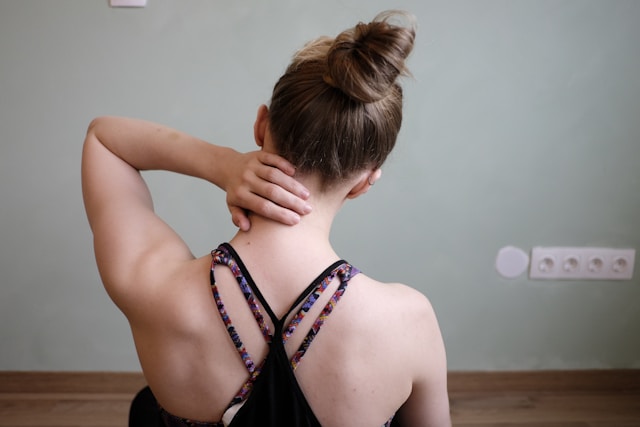Levator Scapulae Stretch Exercise Muscle Stretching can help reduce neck tension and pain. Furthermore, this stretch can improve neck and shoulder mobility.

Practice this exercise daily to alleviate neck tightness and discomfort. Listen to what feels comfortable for your body; never push beyond its limits. Establishing environments and routines which promote healthy posture may also significantly assist.
Levator Scapulae Stretch Exercise :
The levator scapulae muscle is an integral component of both neck and shoulder health, responsible for lifting shoulder blades and tilting heads. Tenseness in this muscle may result from poor posture or overuse; stretching can help alleviate any associated pain and improve stability within shoulder region as well as help avoid headaches as tension in this area can radiate into forehead and temple areas.
Stretching the levator scapulae can be done through various exercises, including shoulder rolls and chin tucks. While anyone can use these exercises, they are particularly beneficial to those who spend long hours sitting down or engaging in repetitive movement activities like golfers or swimmers. Stretches also help alleviate neck stiffness while increasing flexibility of neck muscles.
Levator Scapulae Stretch Exercises can be performed both while lying on your back or sitting in a chair. To perform them properly, first roll back your shoulders slightly and engage your core. Next, move your head to one side while looking down, tucking your chin in towards your chest so it looks like you’re staring directly at your underarm (this makes the stretch feel like its going into your shoulder blade). Use that arm on which your looking down gently pull your head downward until a stretch forms on both the back of your neck and shoulder blade which you can hold for 30 seconds at most!
Maintain your neck mobility with this daily stretch. Just be careful not to overdo it as too much pressure could result in injury to the levator scapulae muscles. If any sharp or intense pain arises during your stretch, release immediately and lower intensity before gradually increasing it as your flexibility improves.
The levator scapulae muscles are heavily utilized by athletes performing overhead motions such as swimmers and Olympic lifters, such as swimming. Regular levator scapulae stretches can alleviate soreness in necks and shoulders of these athletes and enhance performance by expanding neck range and increasing stability within their shoulders and necks.
Levator Scapulae Stretch Exercise Timing :
Repetitively performing the Levator Scapulae Stretch Exercise is an effective way to manage neck pain caused by tightness or injury, making this stretching exercise accessible and user-friendly. Best performed post workout or hot shower when muscles are warm – as this increases both its effectiveness and speed of recovery. Furthermore, avoid stretching these muscles prior to engaging in vigorous physical activities which could increase risk of injuries.

There are two levator scapulae muscles located on either side of the neck. These connect the top portion of the shoulder blade with four cervical vertebrae and play an essential role in turning and lifting of the head, as well as raising of the shoulder blade. They play an important part in turning or raising of head as well as lifting/lowering and raising/lowering it forwards/backwards as well as raising of shoulder blade. They may become tight and tender after long hours spent sitting or standing improperly – either due to bad posture, computer use or long hours using computer/steering wheel/desk usage or because using computer/steering wheel/desk too long; additionally they may play an instrumental role in dropped shoulder syndrome which refers to dropped shoulder syndrome occurring due to weak neck/shoulder combination resulting in dropped shoulder syndrome resulting in dropped shoulder syndrome occurring due to neck/shoulder weakness in either one or both parts of the body causing dropping of shoulder blade due to either weak neck/or shoulder attachment points;
The Levator Scapulae Stretch Exercises are responsible for keeping your chin from dropping too far when tilting forward, and when tight they may make simple movements like tilting forward or placing your chin on your chest more challenging. They may also become the source of neck or shoulder pain if they become overworked or pulled too often.
Start this levator scapulae stretching exercise by sitting down comfortably in a chair with relaxed shoulders. Reach across with your right hand to the back of the chair with your right hand and lightly grasp its backrest with it. Slowly turn your head right, looking down toward your chest (this should make you appear like you are staring directly into an underarm) with one eye closed and looking left until a stretch in your levator scapulae can be felt, holding this position for 30-60 seconds before switching sides and repeat.
Levator Scapulae Stretch Exercise Frequency
The levator scapulae muscle is a thin and flat layer running between the upper shoulder blades and four cervical vertebrae in your neck, commonly tight in those who sit all day such as desk workers or television watchers. By including the levator scapulae stretch exercise into daily routine, people may experience less neck and shoulder discomfort. Do this stretching routine a few times each day prior to neck strengthening exercises for maximum effect.
To perform this stretch, first sit comfortably with shoulders relaxed and core engaged. Reach one hand down and grasp the bottom of the seat; slightly turn your chin downward toward opposite armpit until a comfortable stretch in levator scapulae is felt; hold this position for 20 seconds on both sides three times; repeat to stretch other arm. In addition, standing straight with both arms on either side of head can also work; simply gently pull down on each arm to stretch levator scapulae without overdoing it or using bouncing movements during stretching exercises.
Regularly practicing levator scapulae stretching exercises is beneficial, but creating environments and lifestyles that support strong posture is even better. By setting timers or setting reminders on phones to stretch or stand up every 30 minutes and scheduling neck and shoulder exercises into daily routines, you’re less likely to overuse these muscles, thus preventing stiff and painful necks from occurring. These measures include setting timers at work or scheduling neck and shoulder exercises into everyday schedules.
Regular levator scapulae stretches can improve neck and shoulder mobility, ease pain, and help prevent tension headaches. They’re especially helpful for individuals with forward-leaning postures or participating in activities requiring repetitive shrugging motions such as Olympic weightlifters and swimmers; older adults can also find great benefit, as their flexibility and joint mobility decline with age. Furthermore, the levator scapulae plays an integral role in maintaining proper alignment of shoulders and neck which could otherwise lead to postural issues and chronic discomfort – making regular stretches essential.
Variation
The levator scapulae muscle can often become overactive when someone experiences neck pain and stiffness, leading to symptoms like neck stiffness. Stretching this muscle may help alleviate these symptoms and lower recurrence risk; stretching can also keep this muscle flexible and healthy over time – stretching may also prevent injuries in other parts of the shoulder and neck, such as the sternocleidomastoid and suboccipital muscles.
Researchers recently conducted a study which demonstrated how the levator scapulae muscle can be lengthened in different positions by stretching exercise, with four conditions that varied the spine and upper limb alignment in sitting posture: condition 1 (erect), 2 (erect and drooping), 3 (slouching) and 4 (slouching and behind back). Researchers measured both levator scapulae index and cervical range of motion before and after each stretching exercise position.
Levator Scapulae overactivity is often found among those suffering from neck and shoulder disorders, including pain, stiffness and instability. This may be the result of poor neck posture, slouching or desk jobs with inadequate lumbar support; or from sitting too long without enough lumbar support at work. Overactivity also often causes anterior tilt of the scapula, inhibiting upward rotation while increasing shoulder impingement issues and rotator cuff problems.
Regular levator scapulae stretching exercises may benefit those suffering from neck pain and stiffness, as well as those experiencing tension headaches. They may also prove helpful for athletes performing repetitive movements – for instance Olympic lifters who use shrugging motions, swimmers who utilize shoulders extensively during competition, or cyclists with forward leaning postures could all find relief through such stretching exercises.
At the levator scapulae exercise, subjects must sit with arms at their sides and move their head in a circular pattern around the shoulder. A partner can assist by supporting your torso during this movement. Once feeling a stretch on one side of their neck, hold for 10 seconds then repeat process on other side – this exercise provides a simple means of assessing its function, helping determine whether it has adequate range of motion or not.

